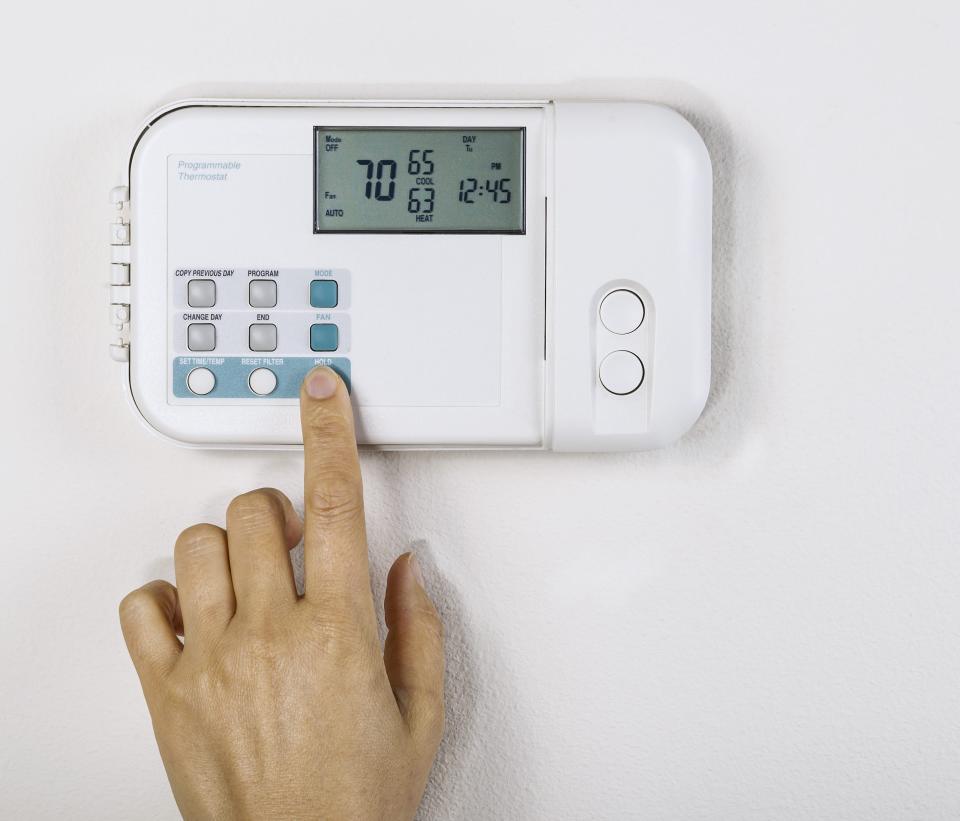Arizona lands $47.5 million to weatherize homes against energy-draining heat, cold
Shirley Moore was reluctant to invite people over to her home in Coolidge because she didn't want them to be too hot or too cold. At 72, she didn't have the income to pay her rising utility bills and had instead devised a system of strategically placed fans and blankets, depending on the season. But it wasn't comfortable.
Then last summer, she heard about the state's Weatherization Assistance Program administered by the Arizona Department of Housing. She filled out forms about her income and when she bought her home, added recent utility bills, and submitted her application to Community Action Human Resource Agency, an affiliate partner.
"I had to do something. I was having a lot of medical (issues) at that time and some of my prescriptions were unbelievably high. It was a struggle. There was never really any little extra to go here or there and I couldn’t save," Moore said.
Within two months, a team of weatherization analysts arrived at her door. They evaluated her home for leaks of cooled or heated air, then sealed it up, re-insulated her attic and crawl space and cleaned and repositioned her internal vents.
"Now I can stand over by my stove and feel the air," she said. "I was just amazed at the things they could do."
Because she met the low-income requirements for the program, Moore didn't pay a cent for her home modifications. She and her 13-year-old Shih Tzu, SugarBabe, can relax at home this summer without worrying about nearly $200 utility bills cutting into her prescription fund.
Loneliness, stress and trade-offs with medications are just a few of the reasons seniors deserve support with high utility costs, said Dora Vasquez, executive director of the Arizona Alliance for Retired Americans, an organization that brings attention to the needs of older citizens.
Financial pressure to keep the thermostat off can put the elderly at increased risk of health complications. Shivering against the cold or sweating to shed excess heat takes a toll on the body, scientists have found, damaging vital organs and compromising the immune system's ability to fight off infection. Limited mobility and isolation can also mean they don't get help when they should. In 2019, an 80-year-old man died from heat exposure in his Scottsdale home while putting off repairs to his air conditioning unit. The temperature inside his home when police arrived that July was 99 degrees Fahrenheit.
"As retirees, we're here to advocate to make sure we're living our best life after a lifetime of work," Vasquez said. "We acknowledge that to live comfortably during that retirement, there are things you need. Across the nation, the average social security is $1,827. That’s all people have to live on."
Children are also at greater risk of health consequences related to temperature extremes, due to their small body size and underdeveloped organs. And research has determined that people disabled by mental or physical health conditions often struggle more to thermoregulate when exposed to high or low temperatures.
Children and heat: Can an 'army of moms' slow climate change to spare their children a fossil fuel future?
Because of these vulnerabilities, a new influx of home weatherization assistance funding for low-income Arizonans will first go to people over the age of 60, families with children age 5 or under and persons with disabilities. But, any household struggling to pay utility bills, renters included, with income below 200% of the federal poverty threshold is encouraged to apply.
That means someone living alone would qualify for assistance if their annual income is less than $29,160 and a family of four would qualify if they make less than $60,000 per year. More details are available on the Arizona Department of Housing's weatherization website.
Supercharging the fight against costs and climate
In typical years, Arizona receives a little over $2 million in federal funding for weatherization from the Department of Energy, said Kathy Blodgett, a programs administrator with the Arizona Department of Housing. As part of a mandate from the Arizona Corporation Commission, some annual funding also comes from Southwest Gas and Arizona Public Service.
This year, Arizona became the first state to get additional weatherization funding from the Bipartisan Infrastructure Law. It received $47.5 million, or enough to retrofit at least 3,400 homes with a maximum investment of $8,009 per unit. About 15% to 20% of the total will go toward administrative costs and training opportunities for people interested in weatherization jobs.
To score these extra dollars, ADOH had to devise and submit a plan for how they would allocate funds, determine need, ensure quality work and monitor the various agencies and companies involved in providing services. Arizona emerged as the first state to pass muster and the funding was allocated in January. By February, Blodgett said, they had already served 12 customers.
"We're just pleased as punch that we were awarded first and able to roll it out immediately," she said. "It helps low-income households not have to decide between paying their utility bill and going to buy their medicine because they don't have the funds to do both," Blodgett said. "It also reduces energy consumption and what they pull off the grid, which saves the whole nation."
Analyzers: The state climatologist office that almost wasn't, and what it does for Arizona now
Growing awareness about the hazards of Arizona's heat may have helped motivate ADOH to submit its plan and the federal government to approve it. Originally, the federal weatherization assistance program was more about helping people in eastern states heat their homes, Blodgett said. "But then when they figured out that the Western states have more hot days, they factored that in."
Caryn Potter, the Arizona representative for the Southwest Energy Efficiency Project, is elated at the possibilities the funding offers for residents and workers. It will also help to fight against climate change, which scientists understand to be caused largely by heat-trapping greenhouse gases emitted when fossil fuels are burned for energy, she said.
When it comes to utility bills, the amount of energy used is one of the few variables customers have any control over, Potter said. She sees this program as empowering low-income families and individuals with more options to reduce energy use without making too many compromises on comfort.
“This weatherization funding boost from federal programs, it's huge for our state," Potter said. "I would say this funding is long overdue. It's incredibly important to help customers deal with the summers that are only getting hotter in Arizona and utility bills that are only getting more and more out of control."
Improving home energy efficiency to reduce the carbon footprint of a growing population is a necessary step in the effort to slow global impacts of warming while communities work toward transitioning to renewable energy sources. The costs to install and operate wind and solar energy are dropping rapidly, and climate scientists predict that mitigating climate change will be cheaper than the cost of reacting to its damage later, meaning home weatherization offers benefits for everyone.
"At a wider scale than just this program, energy efficiency helps to fuel Arizona strategies for tackling climate change and offering more cost-effective ways to mitigate its impacts," Potter said.
Blodgett and her partners in the program did not have an official estimate for how many tons of carbon emissions will be prevented by weatherizing Arizona homes under this new funding. But the federal program requires a 1:1 match of investment to benefit, with the number of dollars spent expected to equal the estimated savings in energy expenditure over the lifetime of the modification.

Federal funds: Without an energy office, will Arizona get its full share of the Inflation Reduction Act?
Building science for the win, for now
Once applicants are approved, the weatherization process starts with a high-tech energy audit.
Using diagnostic equipment called a "blower door," trained technicians identify leaks and collect other "building science" data about how the home's systems work together to determine the most effective weatherization strategies.
"So you can see, having a trained workforce is really going to be critical for the state of Arizona as we look at providing more services through the weatherization program," said Carrie Smith, chief operating officer for FSL, an organization that aims to improve life for adults with options for health, human services and affordable housing.
In response to the need and opportunity generated by the funding from the infrastructure law, FSL's Southwest Building Science Training Center is ramping up efforts to offer professional training and certification programs for those interested in weatherization careers and is expanding its training team and course offerings to help meet local demand for an increased workforce.

The energy audit might indicate a need to replace heating and cooling systems, seal ducts, install water-saving features and upgrade thermostats to programmable models that can help people monitor their energy use.
"We'll tighten up a house and make it as energy efficient as possible," Smith told The Arizona Republic. "But we know that homes have to breathe as well, so now we bring in mechanical ventilation that can control the airflow in the house rather than just having doors and windows open."
ADOH is overseeing the program, but applications will be accepted by several partner organizations listed on its website, including FSL, Community Action Human Resource Agency, Maricopa County, Gila County and Pima County.
There is no official estimate of how many homes in Arizona could benefit from weatherization services. The number likely far exceeds the 3,400 that will receive portions of the new funding.
"The verification process does not always allow every single person or every single household that has a need to be able to go through the program," said Potter of SWEEP. "We recognize that there are a larger number of homes in Arizona that likely need these services."
But with increased workforce training, options for Arizonans to fund their own weatherization services will likely increase. The results would have far-reaching benefits, such as increased comfort for aging residents like Shirley Moore, lifesaving cooling for those sweating out summers inside, crucial savings for low-income families and measurable action against a warming and intensifying climate.
Read the climate series: The latest from Joan Meiners at azcentral, a weekly column on climate change
Joan Meiners is the climate news and storytelling reporter at The Arizona Republic and azcentral.com. Before becoming a journalist, she completed a doctorate in ecology. Follow Joan on Twitter at @beecycles or email her at joan.meiners@arizonarepublic.com. Read more of her coverage at environment.azcentral.com.
Support climate coverage and local journalism by subscribing to azcentral.com at this link.
This article originally appeared on Arizona Republic: Arizona gets $47.5 million to weatherize homes against heat, cold

